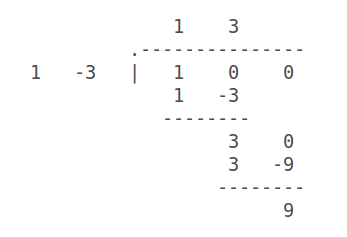How do you find the slant asymptote of #(x^2)/(x-3)#?
1 Answer
Dec 27, 2015
Divide the numerator
Explanation:
You can divide the polynomials in several different ways.
Here's a long division of the coefficients:
Note the
Equivalently, you can add and subtract terms to separate out multiples of the divisor like this:
#x^2/(x-3)#
#=(x^2-3x+3x)/(x-3)#
#=(x(x-3)+3x)/(x-3)#
#=x + (3x)/(x-3)#
#=x + (3x-9+9)/(x-3)#
#=x + (3(x-3)+9)/(x-3)#
#=x + 3 + 9/(x-3)#
In either case, we find that the quotient is
As
#y = x+3#

